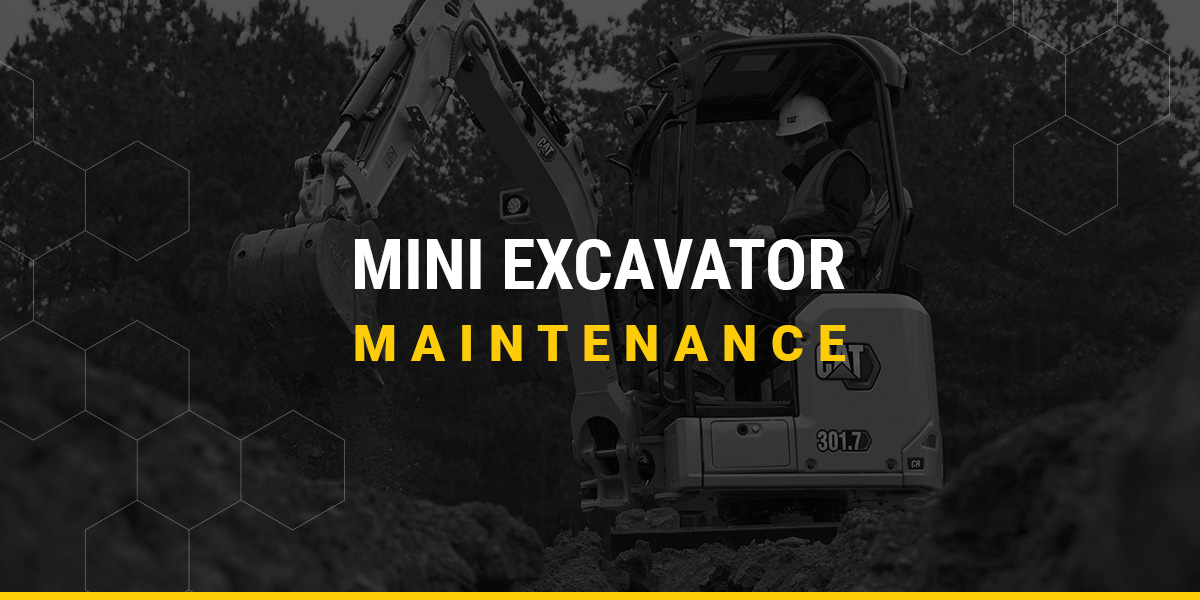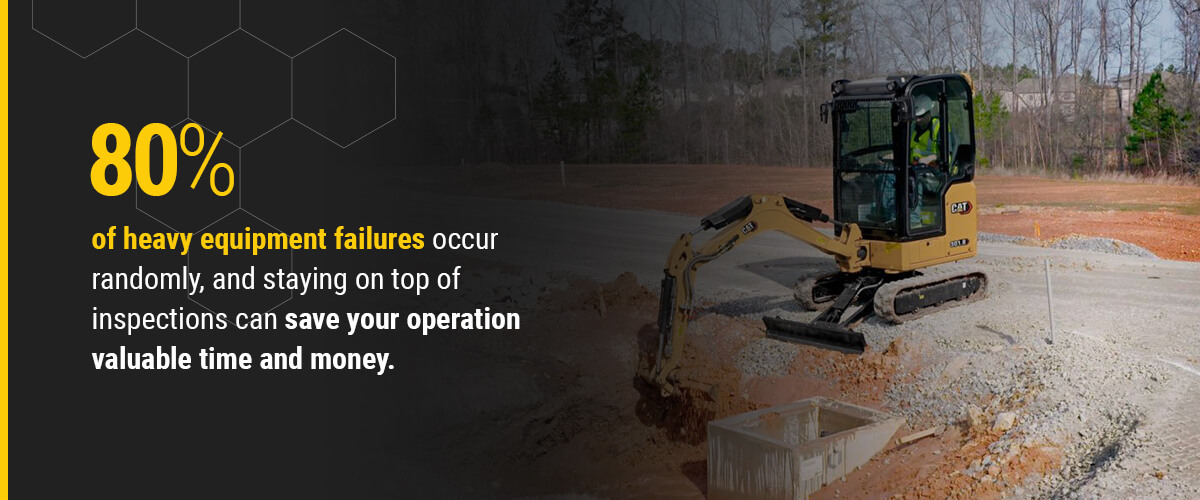
You can avoid many typical maintenance issues associated with mini excavators by regularly tending to your equipment and ensuring its parts are in excellent shape.
Learn more about mini excavator maintenance and getting the most out of your equipment.
Mini Excavator Preventive Maintenance
When performing preventive maintenance on your mini excavator, here are some crucial responsibilities to add to your daily checklist.
- Check oil levels: Remember to look at your engine and hydraulic oil levels. You can save thousands in replacement and repair costs by regularly dedicating a minute or two to checking these.
- Inspect the water and fuel separator: You’ll want to check out the fuel water trap and remove any present buildup to avoid damaging your machine’s engine.
- Check hydraulic hoses: It is beneficial to inspect the hoses on your hydraulic system for potential leaks and cracks.
- Grease pivot points: To reduce wear and tear, you should lubricate your equipment’s pivot points as indicated in the manufacturer’s manual.
- Adjust tracks: Regularly give your equipment’s track tension a look. Whether your track is too loose or too tight, you could damage your equipment and cause an expensive breakdown.
- Inspect your bucket and attachments: To avoid overworking your equipment, pay close attention to your bucket and other attachments. Look for signs of damage and be prompt about replacing worn or broken parts.
- Check for coolant leaks: Study your oil cooler and radiator for possible coolant leaks. If these are severe, they’ll need immediate attention.
6 Benefits of Preventive Maintenance
There are many advantages to performing preventive maintenance on your mini excavator, including the following.
- Protecting your investment: One of the most notable benefits of preventive maintenance is preserving your equipment and maximizing your investment.
- Extending your equipment’s life span: Performing regular maintenance tasks can extend its working life and save you thousands of dollars in repairs and replacements.
- Improving reliability: Downtime can be a headache and often comes with a hefty price. By taking the time to give your equipment the attention it needs, you can enjoy operating with minimal downtime.
- Boosting resale value: When you prioritize preventive maintenance, you can tackle replacements and repairs promptly and ultimately enhance your mini excavator’s resale value.
- Minimizing operating costs: Performing regular preventive maintenance can improve your equipment’s efficiency and effectiveness, reducing how much it costs to keep your mini excavator operating.
- Maintaining safety: By proactively addressing your equipment’s maintenance needs, you can extend the life of safety mechanisms and protect operators from harm. Regular care is essential for ensuring your mini excavator is safe to operate.
Preventive maintenance is especially vital because 80% of heavy equipment failures occur randomly, and staying on top of inspections can save your operation valuable time and money.

Most Common Wear Parts on a Mini Excavator
A mini excavator endures the most wear and tear on its undercarriage and accompanying parts. The most common wear parts include the following.
Sprockets
Sprockets are often the fastest component to wear on a mini excavator, especially if you frequently operate in rough and rocky conditions or perform backfilling operations.
Ensure the sprocket’s teeth are rounded and not sharp or crooked, as this indicates it may be time for a replacement. It is also beneficial to replace these parts when you put new tracks on your mini excavator to maintain your manufacturer’s warranty.
Idlers and Rollers
Check your idlers and rollers for oil leakage around the seals. If you fail to lubricate these seals properly, your idler or roller can seize up due to a bearing failure. Without enough shots of grease, the heat generated by the friction between parts can also compromise these seals.
Tracks
Last but certainly not least, the track on a mini excavator is another common wear part. If the track has any of the following issues, it is likely time to replace it:
- It has exposed cables.
- Pieces of rubber fell or tore off.
- It is missing links.
How Do You Change the Tracks on a Mini Excavator?
Follow these steps to change tracks on a mini excavator.
- Step 1: You’ll need to lift the machine’s track. Some machines have a blade that pushes into the ground to lift the excavator, while others will require you to use the boom and bucket for the job.
- Step 2: Put the safety level in place to prevent the equipment from dropping during maintenance. Prioritize this precaution to avoid serious safety concerns.
- Step 3: Release the track’s tension so you can loosen it enough for removal.
- Step 4: Using a chisel bar, move the idler in to create a gap and loosen the track.
- Step 5: With the chisel bar underneath the track and an operator firing the machine, you can use the bar to walk the track off. Be sure to remove the track from the back and front idler.
- Step 6: Lower the machine. Then, lift the track onto the carrier roller and sprocket before lifting the machine and putting the replacement track on the idler.
- Step 7: While the track is moving forward, use the chisel bar to pop it into place.
- Step 8: Adjust the track’s tension and test it by moving forward and backward.
Other Frequently Asked Questions About Maintenance
Here are some commonly asked questions regarding mini excavator preventive maintenance.
How Many Hours Are There on a Mini Excavator?
A well-maintained mini excavator has a maximum life span of approximately 10,000 hours. Consider working with a dealer for the best-quality maintenance services from factory-trained technicians to maximize how long your equipment runs.
Do Mini Excavators Hold Their Value?
Compact machines like mini excavators tend to hold their value better than full-sized equipment.
How Do You Refit an Excavator Track?
If your excavator track needs refitting, you can follow some of the steps you take to change the track. Ensure you leave about an inch of room between the track and the machine’s roller when adjusting the tension and test the fit before getting back to work.
Find the Right Mini Excavator at Stowers Cat
Are you ready to invest in a new or used mini excavator? Trust Stowers Cat as your dealer. We can find you the equipment you need, thanks to our extensive resources and broad inventory throughout the global Cat® dealer network.
We have six locations and a team of professionals to assist you throughout the financing process to ensure you find the best products for your needs. We also offer post-purchase follow-ups to ensure your equipment is performing as it should and is meeting all your expectations.
Are you interested in learning more about the mini excavators available at Stowers Cat? Get in touch with us today!

